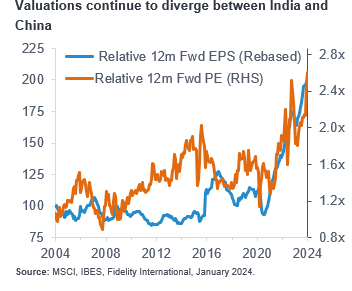The widening divergence in performance and valuations between India and China stock markets has been a notable feature of Asia’s investment landscape over recent times. Fidelity Asian Values PLC (LON:FAS) Investment Director Catherine Yeung highlights what has been driving this dynamic, how long it can endure and what it means for the positioning of the strategy in these key markets.
Key points
- Indian stocks are trading at around 22x earnings, compared to just 9.2x for China – near their biggest valuation gap ever.
- While India has undeniably strong growth prospects, our value focus means that the trust’s exposure is close to the lowest levels it has been since 2015, with holdings focused on more attractively valued larger companies.
- When it comes to China, we believe there is a significant margin of safety in owning a basket of well-financed and well-managed companies, especially small-cap names.
Indian stocks are currently near their most expensive levels against their Chinese peers, which have come under increasing pressure due to investors’ concerns about the recovery in both China’s economy and its stock market. The gap demonstrates the value that investors are placing on India’s improving earnings prospects despite the very cheap levels available in China.

India offers a fast-growing alternative to China with a booming consumer sector, growing capex and likely benefits from the shift in global supply chains. However, there are risks around valuations, and potential for volatility around upcoming elections, which should be beneficial for the long-term health of the market.
The country has also seen a surge in domestic fund flows to a 23-month high of US$3.2 billion in February via systematic investment plans. This has counterbalanced foreign flows which have historically been more volatile and further supported Indian equities. Notably, in mid-January, India even briefly overtook Hong Kong to become the world’s fourth-largest equity market, and Morgan Stanley analysts predict it will become the third largest by 2030[1].
In contrast, sentiment towards China over recent times has been weighed down by concerns of a slower than expected economic recovery, regulatory pressures and ongoing geopolitical tensions with the US. In recent weeks, however, China’s equity markets have rallied following better-than-expected consumption trends during the Lunar New Year. Strong travel and spending data, as well as the central bank’s decision to cut a key mortgage rate have boosted sentiment. Additionally, we have seen other modest growth policies being announced following the National People’s Congress. However, China remains cheap – especially versus India.
How we’re positioned in these two markets
Historically, India has tended to be one of the more expensive markets in Asia, with its valuation premium increasing versus the rest of region more recently. Notably, the small-cap index in India is now around 40% more expensive than Asian small-caps and 30% more expensive versus Indian large-caps.
Given the strategy’s focus on finding good companies, run by good management teams at a good price (or with a margin of safety), our exposure to India is close to its lowest levels since Nitin Bajaj took over managing the trust in 2015. Our holdings in India are largely focused on well-run larger companies, which are trading at more attractive valuations but, at the same time, are good long-term compounders with attractive tailwinds given the industries in which they operate.
For example, one of our largest holdings is in India’s fourth largest mortgage financier LIC Housing Finance which has been strong contributor to returns. Promoted by Life Insurance Corporation, India’s largest and fully-state owned insurance company, this business has access to low-cost funds, helping it focus mainly on prime borrowers and maintain high returns on equity and strong asset quality. From a valuation perspective, the stock is currently trading at par with its one-year forward book value and seven times its one-year forward earnings.
When it comes to China, despite generally weak investor sentiment, we believe there is a significant margin of safety in owning a basket of well-financed and well-managed companies, especially small-cap names. These companies tend to have well-financed balance sheets and sound business models that should increase in value during a market up-cycle. Moreover, the portfolio stands to benefit from expectations of improving earnings and re-ratings.
Given this, our exposure to Chinese equities (Hong Kong and China) remains at one of the highest levels since Nitin’s tenure (the opposite positioning to India) and we have incrementally added to several long-term structural beneficiaries in the consumer space, such as retail chain drug sellers bolstered by a gradually ageing population in China, or leading domestic players in under-penetrated dairy and sportswear industries.
Looking ahead
As we look ahead, there are many expectations that India will become the ‘giant of the region’ when it comes to GDP growth. As a result, we expect valuations to remain relatively high as more investors take a position in India given its growing profile (not just equities but also in fixed Income, with India now included in JPM’s EM bond index).
However, we do expect more volatility in India going forward and any correction should be positive for the long-term health for the market. As the margin of safety re-emerges, we’ll look to incrementally add to several long-term structural beneficiaries which have been on our watch list but not owned due to expensive valuations.
For China, as the world’s second largest economy, and with the continuation of its targeted accommodative policy support, we strongly believe both the earnings and multiples of our Chinese holdings will rerate and recover from recent levels.
We are cognisant of the current challenging economic backdrop in China. While this could bring some volatility in the short-term, it could also present unprecedented opportunities. However, what we feel is often missed are the stories of great individual companies with good businesses where valuations are dragged down by the macro headlines. Our focus remains on finding these companies through extensive bottom-up, fundamental-driven research. As long as we remain disciplined in our process, we believe we should be rewarded in the medium to long term.
The value of investments and the income from them can go down as well as up, so you may get back less than you invest. This information is not a personal recommendation for any particular investment. If you are unsure about the suitability of an investment you should speak to an authorised financial adviser. Investors should note that the views expressed may no longer be current and may have already been acted upon. Fidelity Asian Values PLC can use financial derivative instruments for investment purposes, which may expose them to a higher degree of risk and can cause investments to experience larger than average price fluctuations. This trust invests more heavily than others in smaller companies, which can carry a higher risk because their share prices may be more volatile than those of larger companies. Investments in small and emerging markets can be more volatile than other more developed markets. The shares in the investment trust are listed on the London Stock Exchange and their price is affected by supply and demand. The investment trust can gain additional exposure to the market, known as gearing, potentially increasing volatility. Reference to specific securities should not be construed as a recommendation to buy or sell these securities and is included for the purposes of illustration only.
The latest annual reports, key information document (KID) and factsheets can be obtained from our website at www.fidelity.co.uk/its or by calling 0800 41 41 10. The full prospectus may also be obtained from Fidelity. The Alternative Investment Fund Manager (AIFM) of Fidelity Investment Trusts is FIL Investment Services (UK) Limited. Issued by FIL Investment Services (UK) Limited, authorised and regulated by the Financial Conduct Authority. Fidelity, Fidelity International, the Fidelity International logo and F symbol are trademarks of FIL Limited.
[1] India Economic Boom: 2031 Growth Outlook | Morgan Stanley





































